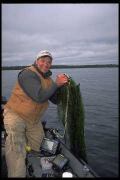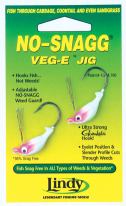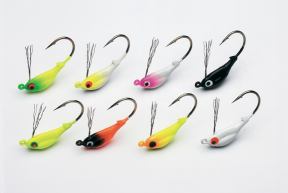BOHN SLIP FLOATS MILLE LAC”S LAKE
By Ted Takasaki and Scott Richardson
There’s a reason legendary Wisconsin guide Greg Bohn makes frequent pilgrimages to Minnesota’s Mighty Mille Lacs.
He’s known as Mr. Slip Bobber, and he thinks Mille Lacs is the slip-bobber capital of the world.
That’s especially true when the water temperature hits 70 and above.
“The walleyes come right up on top of the rock bars,” said Bohn, who authored the new book, “Master the Art of Slip Bobbering: the Deadliest Method for Walleye,” with outdoor writer Scott Richardson. “It’s terrific.”
Bohn has spent the last 30 years perfecting the tactic that is one of the most used and least understood in walleye fishing.
Most anglers view bobbers as a secondary technique. Not Bohn, who designed the new Pro-Series Slip Bobbers, Rigs and Snells for Lindy Legendary Tackle. As a guide whose clients include novice anglers, he was forced to fine-tune a method of fishing that was both effective and easy to use. Slip bobbering is it.
Slip bobbers are for experienced anglers, too, because they work. Bohn’s guided clients have been known to catch 250 walleyes in a weekend.
“My question is, what else is out there that can catch 200 plus walleyes in a weekend,” said Bohn, “It usually out-fishes everything else we are doing, After a while of watching someone catch fish after fish after fish with a slip bobber, it’s like, Hey, give me one of those things.”
The set-up Bohn describes is not the sloppy contraption that commonly passes for a slip bobber rig. You better think Hi-Tec rigging according to Bohn!
Most people start by sliding on any old slip knot or plastic bobber stop. They follow that with a cheap bobber that sometimes slides, sometimes not. They tie on a hook and crimp split shot on the line. Make no mistake. That’s not a slip bobber rig. It’s a recipe for disaster.
Plastic and rubber bobber stops have their uses, especially when you have to retie when bites are coming fast and furious. But high-quality thread stops are best to hold at the proper depth longer without slipping out of place or damaging the line.
Toss out the those plastic beads that come with most stops. They stick, causing the bobber to stand upright before the bait reaches the desired depth. Bohn has searched the world for the best uniform beads to insure they slide easily. He markets them as a Pro Bead Rigging Kit which work great partnered with the Lindy weighted and unweighted Pro Series bobbers.
Split shot? No. With rare exceptions like the Thill Soft Shot, split shot damages line and reduces perfectly good 8-pound test to 4-pound or 2-pound.
“As soon as you pinch split shot on the line and lose a 5-pound walleye at the boat, you’ll know you have the wrong weight,” Bohn said.
Instead, small rubber core sinkers are damage free. Another advantage of rubber core, when line is snagged, it’s usually the weight that’s caught. With split shot, that means a break off and losing precious time as you retie. With a rubber core, simply pull. The rubber core slides and works free. The rig also can be modified with Timb’r Rock Jigs or NO-SNAGG hooks to avoid snags in the first place.
For most uses, the business end of the rig usually consists of a #4 or #6 aberdeen gold or red hook. Aberdeen-style hooks are best to avoid damaging bait, which must stay lively to do it’s job. Jump to a #2 for big chubs and leeches.
Bohn also designed a hybrid between a jig and a hook he calls the Jig Bug. It has a small amount of weight of one-thirty-second or one-sixteenth ounces, on an oversized hook. That helps keep the bait from swimming out of the strike zone, but it’s small enough to be inhaled with the bait when a walleye strikes.
Bohn adds another red bead above the jig, hook or Jig Bug for extra attraction.
At Mille Lacs, local custom is to use relatively big jigs of one-eighth or even one-quarter of an ounce coupled with Lindy’s Mille Lacs slip bobber. Instead, Bohn prefers to keep the jig size small so a hungry walleye is sure to get the point when it inhales a jumbo leech. If more weight is desired, add it to the line in the form of a larger rubber core sinker, not the hook. Bohn was quick to comment..if more walleye anglers use the Pro-Bead and Pro-Blade Rigging Kits, their slip float walleye fishing will never be the same again!
Whole nightcrawlers highlighted by glass beads and blades are dynamite at Mille Lacs in summertime, too, as well as leeches. But, if perch are around, they’ll peck at the bait and ruin its looks. And, in slip bobbering, it’s critical for the bait to appear lively and natural.
When you’ve decided on a spot to fish, set the depth so the bait rides just one foot off the bottom. Bohn uses a depth finding sinker common in ice fishing. He lets it go to the bottom, reels the rod tip to the surface of the water and then slides the slip knot to within one foot of the rod tip.
Where to fish? That’s an important question on a lake the size of Mille Lacs. The best spots are gravel points with boulders mixed in that come way out into the lake, Bohn said. Names like Indian Point and Brown’s Point come to mind. Best depths are often 19- to 23 feet.
Like most big water, the wind helps concentrate fish on Mille Lacs. It’s important to know which direction the breeze is blowing that day, but it’s even more important to know which way it’s been blowing a day or two before. The wind moves the food chain to the windy side. It also helps impart action to the bait.
“I love it when the wind blows over the tops (of structure.) It moves the bobber around which is very helpful,” Bohn said.
Mid-lake reefs are popular, too, and if it’s numbers of walleyes you want rather than size they may be the spots for you. Try Garrison’s Reef, Hennepin Island and Banana Reef. Three Mile Reef tops out at about 17 feet, but look for several bars that jut out from it and top out at 22 feet.
Bohn also loves to drift over Anderson’s Reef. GPS or marker buoys are a must on large areas like that. Enter a waypoint or toss a buoy each time a fish strikes, then return to those spots and anchor so you can cast into the wind and let the wind drift your bait across the spot.

 Early-season weed walleyes are not exclusive to America’s Northwoods. Fishermen in the nation’s Southland find spring walleyes roaming highland reservoirs over beds of moss, a kind of water hyacinth, said John Holstine, founder of the Arkansas Walleye Association.
Early-season weed walleyes are not exclusive to America’s Northwoods. Fishermen in the nation’s Southland find spring walleyes roaming highland reservoirs over beds of moss, a kind of water hyacinth, said John Holstine, founder of the Arkansas Walleye Association. BRAINERD, Minn. – Lindy Little Joe has introduced a new weed-defying jig to complement their leading NO-SNAGG line. Manufactured from a design by Greg Bohn and incorporating Lindy’s patented NO-SNAGG seven-strand wire guard, the VEG-E-JIG offers 95 percent snag-free operation in heavy vegetation, a prime feeding ground for walleye, northern pike and bass.
BRAINERD, Minn. – Lindy Little Joe has introduced a new weed-defying jig to complement their leading NO-SNAGG line. Manufactured from a design by Greg Bohn and incorporating Lindy’s patented NO-SNAGG seven-strand wire guard, the VEG-E-JIG offers 95 percent snag-free operation in heavy vegetation, a prime feeding ground for walleye, northern pike and bass.